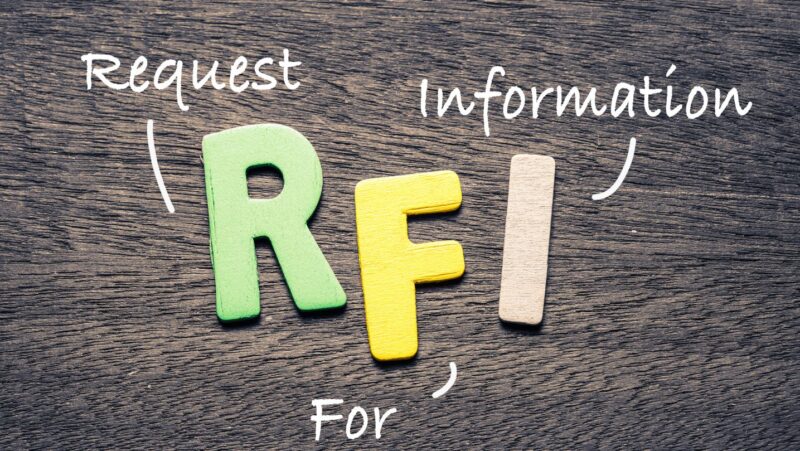 You may be thinking that responding to a Request for Information (RFI) is just another tedious task on your already overflowing to-do list. But here’s the thing: understanding the basics of RFI responses can actually save you time, money, and headaches in the long run.
You may be thinking that responding to a Request for Information (RFI) is just another tedious task on your already overflowing to-do list. But here’s the thing: understanding the basics of RFI responses can actually save you time, money, and headaches in the long run.
In this discussion, we’ll explore the importance of RFI responses, the key components of an effective response, best practices for crafting compelling responses, and common mistakes to avoid.
So, if you’re looking to increase your chances of success in the business world, keep reading to discover how mastering the art of RFI responses can give you a competitive edge.
Importance of RFI Responses
Understanding the importance of RFI responses is essential for effectively engaging with potential vendors and gathering the necessary information for successful project planning. Responding to RFIs provides several benefits and advantages that can greatly impact the outcome of your project.
Firstly, RFI responses allow you to evaluate the capabilities and expertise of potential vendors. By requesting information about their past experiences and qualifications, you can assess whether they align with your project requirements. This helps you identify vendors who have the necessary skills and resources to meet your needs, saving you time and effort in the long run.
Secondly, RFI responses enable you to gather crucial information that can influence your project planning. Vendors may provide insights on industry trends, best practices, and innovative solutions that you may not have considered. This information can help you make informed decisions and enhance the overall quality of your project.
Additionally, RFI responses facilitate communication and collaboration between you and the vendors.
Through this process, you can establish a clear understanding of expectations, timelines, and deliverables. This ensures that both parties are on the same page and fosters a productive working relationship.
Key Components of an Effective RFI Response
To create an effective RFI response, include key components that provide clear and concise information about your company’s qualifications and capabilities. One important component is the use of RFI response templates. These templates can help streamline the response process by providing a consistent format and structure. They also ensure that all necessary information is included, making it easier for the recipient to review and evaluate your response.
Another key component is effective communication strategies. Clearly and concisely communicate your company’s qualifications and capabilities, highlighting relevant experience, expertise, and success stories. Use bullet points and headings to organize information and make it easier to read and understand. Avoid using technical jargon or acronyms that may confuse the reader. Instead, use plain language and provide explanations when necessary.
Additionally, make sure to address all the requirements and questions outlined in the RFI. Provide specific and detailed responses that demonstrate your understanding of the client’s needs and how your company can fulfill them. Avoid generic or vague statements and provide evidence or examples to support your claims.
Ultimate Practices for Crafting RFI Responses
Crafting an effective RFI response requires careful attention to detail and a focus on providing clear and concise information. To help you create a response that stands out, here are some best practices, tips, and tricks to keep in mind.

Firstly, make sure you thoroughly understand the requirements outlined in the RFI. Read the document multiple times and highlight key points to ensure you address them adequately.
Next, organize your response in a logical and structured manner. Use headings, bullet points, and numbered lists to make it easy for the reader to navigate through the information.
Another important practice is to tailor your response to the specific needs and interests of the requester. Show that you have taken the time to understand their business and demonstrate how your solution aligns with their goals.
Additionally, keep your response concise and avoid unnecessary jargon. Use clear and straightforward language to convey your message effectively. Be sure to answer all the questions asked in the RFI, providing detailed explanations when necessary.
Lastly, proofread your response multiple times to ensure it’s error-free. Spelling and grammar mistakes can create a negative impression and undermine your credibility.
Common Mistakes to Avoid in RFI Responses
To ensure that your RFI response is effective, it’s important to be aware of common mistakes that should be avoided. By understanding these pitfalls, you can improve your chances of success and stand out from the competition.
One common mistake is providing incomplete or vague answers. It’s crucial to address all the questions in the RFI thoroughly and provide specific details.
Another mistake to avoid is submitting a response that isn’t tailored to the needs of the client. Take the time to understand the client’s requirements and customize your response accordingly.
Additionally, failing to meet the submission deadline is a grave error. Make sure to plan your time effectively and submit your response before the deadline.
Lastly, neglecting to proofread your response can lead to embarrassing typos and errors. Always take the time to review your work and ensure it’s error-free.







